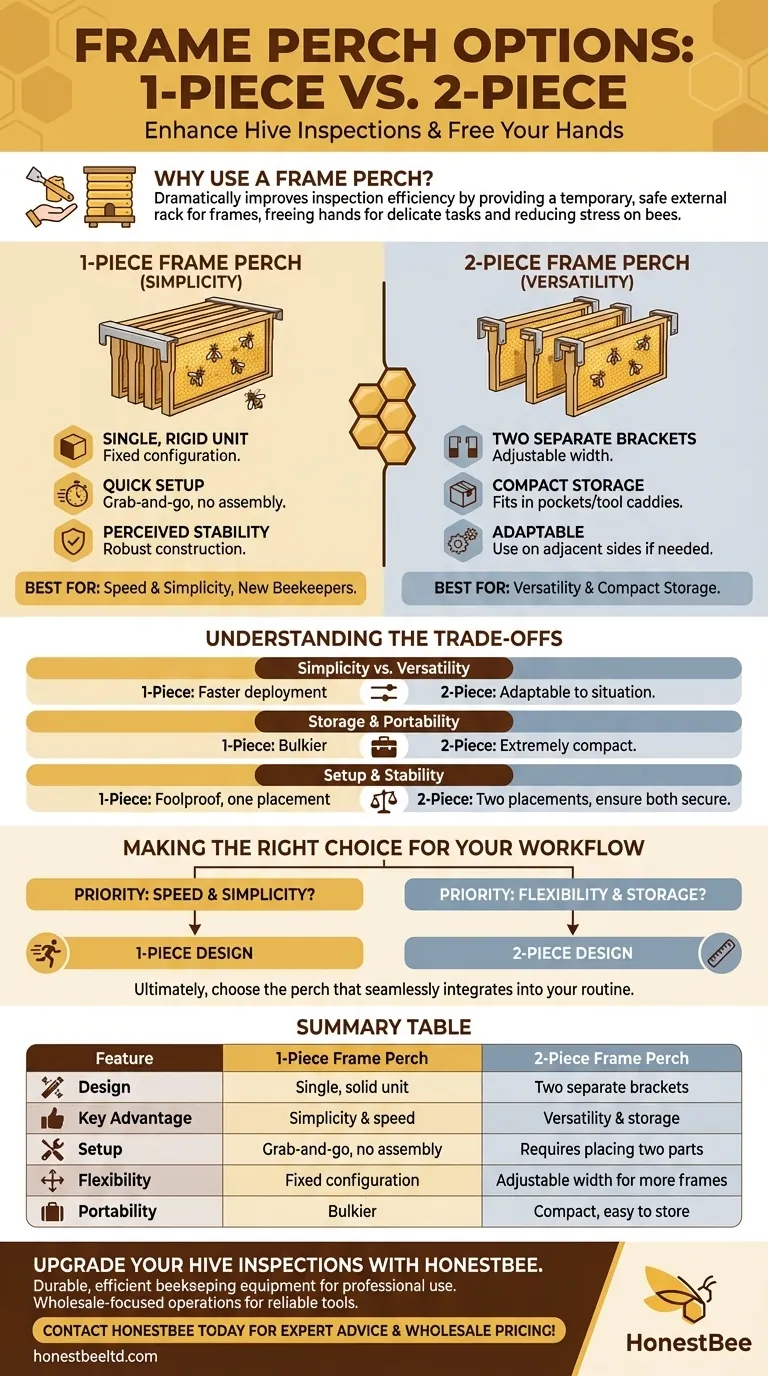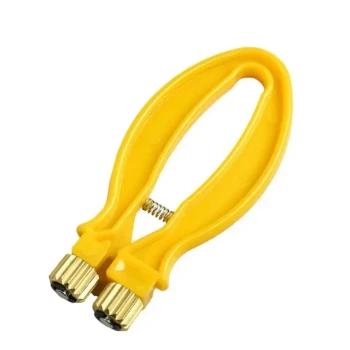In short, frame perches are available in two primary designs: a single, solid 1-piece unit or a more flexible 2-piece set. Both are designed to attach to the side of your hive body, providing a temporary, external rack to hang frames during an inspection and freeing up your hands for more delicate work.
While both 1-piece and 2-piece frame perches solve the same core problem, the choice between them hinges on whether you prioritize the absolute simplicity of a single unit or the versatility and compact storage of a two-part system.
Why Use a Frame Perch at All?
Before comparing designs, it's crucial to understand the problem they solve. A frame perch is a simple tool that dramatically improves the hive inspection process.
The Challenge of Manual Inspections
A standard hive inspection involves a juggling act. You must lift heavy, bee-covered frames, hold them steady for examination, and often use a hive tool or brush simultaneously, all while trying not to drop a frame or anger the colony.
This process is inefficient and can be stressful for both the beekeeper and the bees. It often leads to setting frames on the ground or leaning them against the hive, which risks injuring the queen, chilling the brood, or picking up pests.
Freeing Your Hands for Better Beekeeping
A frame perch provides a dedicated, safe place to hang the first one or two frames you remove. This creates the working space you need inside the hive box.
With your hands free, you can inspect subsequent frames more carefully, take notes, photograph potential issues, or handle your smoker and hive tool without difficulty.
Deconstructing the Two Designs
The functional difference between the options comes down to their physical construction.
The 1-Piece Frame Perch
This is a single, rigid unit, typically made of metal, that hooks over the edge of the hive body. It has pre-set rests to hold two or three frames.
Its primary advantage is simplicity. There is nothing to assemble; you simply hang it on the hive, and it's ready to use. It is often perceived as being very stable and robust due to its solid construction.
The 2-Piece Frame Perch
This option consists of two separate, smaller brackets. Each bracket hooks independently onto the hive body.
The main advantage here is versatility. You can place the two pieces as close together or as far apart as you need, allowing you to create a wider rack to hold more frames if necessary. They are also extremely compact for storage and fit easily into any beekeeper's tool caddy.
Understanding the Trade-offs
Neither design is inherently superior; they simply optimize for different priorities. Choosing the wrong one for your workflow can lead to minor but consistent frustration.
Simplicity vs. Versatility
The core trade-off is straightforward. The 1-piece design is faster to deploy but offers no flexibility. You get a fixed amount of space in a fixed configuration.
The 2-piece design requires an extra second to place both brackets but allows you to adapt to the situation. For example, you could place them on adjacent sides of the hive if space is tight.
Storage and Portability
For beekeepers with limited space or those who carry their tools to multiple apiaries, the 2-piece design is the clear winner. The small, separate brackets can be tucked into any pocket or corner of a toolbox.
A 1-piece perch, being a single, larger object, is bulkier and can be more awkward to store and transport.
Setup and Stability
While both are stable, the 1-piece perch can feel more foolproof. You place it once, and it's set.
A 2-piece perch requires you to place two separate items. While not difficult, it's one extra step and requires you to ensure both brackets are seated securely on the hive wall.
Making the Right Choice for Your Workflow
To decide, consider how you approach your hive inspections and what you value most in a tool.
- If your primary focus is speed and simplicity: The 1-piece design is the most straightforward option, offering grab-and-go convenience with zero setup.
- If your primary focus is versatility and compact storage: The 2-piece design offers superior flexibility for different hive setups and fits easily in any toolkit.
- If you are a new beekeeper: The 1-piece perch is often the easiest to manage, removing a small variable from the already complex process of learning hive inspections.
Ultimately, the right frame perch is the one that seamlessly integrates into your inspection routine, making the process calmer for both you and your bees.
Summary Table:
| Feature | 1-Piece Frame Perch | 2-Piece Frame Perch |
|---|---|---|
| Design | Single, solid unit | Two separate brackets |
| Key Advantage | Simplicity & speed | Versatility & storage |
| Setup | Grab-and-go, no assembly | Requires placing two parts |
| Flexibility | Fixed configuration | Adjustable width for more frames |
| Portability | Bulkier | Compact, easy to store |
Upgrade your hive inspections with the right frame perch. Whether you manage a few hives or a large commercial apiary, HONESTBEE supplies durable, efficient beekeeping equipment designed for professional use. Our wholesale-focused operations ensure you get reliable tools that streamline your workflow. Let us help you choose the perfect equipment for your needs. Contact HONESTBEE today for expert advice and wholesale pricing!
Visual Guide

Related Products
- Heavy-Duty T-Style Frame Perch
- Heavy-Duty Stainless Steel Clip-On Frame Perch
- Multi-Function Hive Tool with Integrated Hammer for Beekeeping
- HONESTBEE Wired and Assembled Wooden Bee Frames Foundation for a Thriving Hive
- Yellow Plastic Bucket Pail Perch for Beekeeping
People Also Ask
- What are the main parts of a hive frame? A Guide to Modern Hive Anatomy
- What are the advantages of using a frame rest for the bees? Achieve Calmer, Safer Hive Inspections
- Why is a frame perch considered essential in an apiary? Ensure Hive Safety & Inspection Efficiency
- How many frames can a frame perch hold? Optimize Your Hive Inspections with the Right Tool
- What is the purpose of the beehive frame perch? Improve Hive Inspection Safety & Efficiency



















